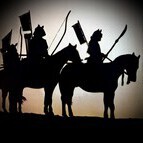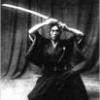
lancashireparade
Members-
Posts
11 -
Joined
-
Last visited
Profile Information
-
Gender
Male
-
Location:
Ontario, Canada
-
Interests
Iaido, micro-enterprise, mentoring and international development.
Profile Fields
-
Name
Neil D
Recent Profile Visitors
215 profile views
lancashireparade's Achievements
-
Help me finish this Mei
lancashireparade replied to lancashireparade's topic in Translation Assistance
Thank you all! I kind of figured Google translate wasn't going to win me the day, but I was really trying to find how to pronounce what I had found. I wondered at first if the first two characters were combined, but I was having trouble finding anything that looked like the two of them together. Then I stumbled on this site that helped me figure out the radicals a bit better, (Jisho.org: Japanese Dictionary)But clearly my inexperience won out. Much appreciated, and much learned! My apologies about the picture. I had rotated it for myself, but when I uploaded it reverted to its original position. Thanks, Neil -
I have been trying to learn how to read Mei, and this sword I believe is from the 16th or 17th century. As I read the characters, I think I have narrowed it to the following: 羊找肋 These characters together don't show up in the Nihonto Club sword database, so I am running out of ideas as to where to find this smith. Running this through Google Translate gets me "Lamb Ribs" which is either unfortunate or misleading. Is anyone able to help me push this across the finish line? Thanks, Neil
-
Sukesada Mei
lancashireparade replied to lancashireparade's topic in General Nihonto Related Discussion
Hi All, thank you so much for your courteous and patient replies. Art sword or not, it's amazing to me the depth of discovery one can enjoy in this pursuit. I am so grateful for all the knowledge put together in all these answers. @Alex A Thank you for pointing me to the AOI site that shows the hamon on a Sukesada wakizashi - that looks very similar to what I can see on mine - the suguha from the hamachi and then moving to gunome midare. @Jacques D. Thank you for showing me that page in Nagayama's book. Are copies of that book still available somewhere? what's the title? Also, there is nothing on the ura side of the nakago, so the omote side is all I have to go on. So between your points and the other thoughts by others I take away the following: - the blade is most likely kazuuchi mono unless made very early or very late in the tradition - It's highly likely the blade itself is 16th century - the blade is likely of low or mediocre quality (but hey, somebody(s) thought it was good enough to keep for 500 years....) - To get further, it really needs to be looked at by someone with knowledge ( I look forward to the time when the Toronto Sword Club can meet again @b.hennick!) Together you have led me to so many reading sources it will keep me occupied for months. I am very grateful to you all for the time you have spent answering my newbie questions! Thanks! Neil -
Sukesada Mei
lancashireparade replied to lancashireparade's topic in General Nihonto Related Discussion
Ok, perhaps a few small answers to the questions above: @DoTanuki yokai, I should have footnoted where I got the idea that the longer the signature the better the blade. It comes from the bottom of this article by David E.J. Pepin called "Bizen Province" The Pinnacle of Sword Production" from 2005. In it he states: That said, I have stopped here at present, and should note this is from a sales pitch to sell a Sukesada blade. So until this information can be coroborated in some way, I cannot tell if its true or BS. But this is why this information appears in an earlier post as part of my notes. As for a picture of the nakago, you are absolutely correct that my photography and lighting stink. but this is the best I can get: I love the mei - its so crisp and sure with an almost delicate flair. I wish I could do a better photography job with my desk lamp and cell phone. @Alex A the sword you showed me here seems to have a similar hamon, where I can still see remnants of it. And its quite thin near the Hamachi. Mostly I can only see a shadow of it because someone cleaned rust off it with steel wool and that has really done a number on the polish. The grain is nearly invisible, and i really can't tell if it is similar to this blade or not. And my total newbie mistake for pasting hira zikuri into the post. Of course it's shinogi-zikuri! I don't know what I was thinking. However, is it strange that there is no yokote? So in the end, to move further along the identification process, do I have to wait until it's polished to see the grain and hamon? Is there any further I can go with this? Neil -
lancashireparade started following A Sukesada Wakizashi? , Sukesada Mei and Mekugiana - Drilled or Punched?
-
Sukesada Mei
lancashireparade replied to lancashireparade's topic in General Nihonto Related Discussion
Hi @Alex A, I've been following a some templates to describe the sword and trying to fill them out according to what I see: So here goes: Signature : Nagamei on Omote side (Long Signature) - 備州長船祐定 Bishu Osafune Sukesada. Ubu: No evidence of suriage (shortening) Location: Bizen Province (Modern Okayama prefecture) Quality: The six character Mei suggests Jo-Saku and according to one sword order from a daimyo, this level of sword was for upper grade commanders and generals. Mekugiana : Single hole. Possibly punched as there is no burr on either side. The blade is not polished. Blade length Overall : 66.99 cm or 21 inches. Nagasa: 53.5 cm or 21 1/16 inches Nakago: 13.3 cm or 5 1/4 inches. Nakago Desription Sori : 18.5 mm Kissaki : no distinguishable yokote Width at the hamachi : 30.5mm Width at the Kissaki : 20.1 mm Kasane : 6.5 mm at Hamachi or 4.8 mm at Kissaki Era : The rust on the tang is rich and black indicating 16th century perhaps? Village of Osafune was destroyed by flood in 1590 Shape : It is in hira zukuri with a centered sori (Torii Sori) If you can help me shed any light on this blade, its age, or especially it's smith, i would be most grateful. I am on the list with David Hofhine to get it polished, but that won't be until sometime in 2023..... I think what I like particularly about this blade is that is possibly connected to the turbulent time between Oda Nobunaga, Toyotomi Hideyoshi and finally Tokugawa Ieyasu. There is a great series on Netflix called Battle For Japan which really brings this period of history to life. I love the thought that this piece of steel is connected to that era..... -
I am taking a closer look at the six character Bishu Osafune Sukesada mei on my wakizashi. Is there a place that would have a rich collection of photos and/or oshigata where I could compare my signature with others that may have identified the smith? The sword is in poor/fair polish, so many of the details of the forging are hard to discern - plus the fact that I have an utterly unpracticed eye. I am really looking to see if I can nail down an era and maybe even a smith....... Thoughts? thanks, Neil
-
Mekugiana - Drilled or Punched?
lancashireparade replied to lancashireparade's topic in General Nihonto Related Discussion
Thank you all! I think I can see the differences, but they are certainly subtle. Jacques, those are some beautiful mei, and I have never seen one with an engraving before! Thanks, Neil -
I have been searching the forums about punching vs drilling and how to tell. The best I have come up with is that it's not the shape that's the true indicator, but the pillowing of metal where the bit emerges from the steel. However, I can't seem to find any good comparative examples. When did drilling first become a standard practice? And how could one definitively tell if a mekugiana is drilled or punched? Here is what I am looking at:
-
Wow, these are really great responses and I have my homework cut out for me. I will read with interest! Earlier in this thread Geraint and Mark C asked me to provide some measurements. I'm using the measuring rules from this page: Japanese SWORD MEASUREMENT (japaneseswordindex.com) . According to this, this torii sori shoto has the following: Nakago: 5.5 " Nagasa: 21" Kissaki 1 1/16" Also, I have been looking for images of a punched mekugi ana, because I am wondering how to tell if mine is drilled or punched as per Mark C
-
Perfect! you have given me some places to start learning some more. I am VERY grateful for all the helpful comments and I will definitely re-post with some measurements. If there was one book or article that people found impacted their knowledge most of sword appreciation, what would it be? Thank you all so much for the time and effort you have already put into my post. Regards, Neil
-
Hi all! I am really new at nihonto and enjoying the challenge and all the learning that goes with it. I recently purchased this wakizashi at auction and I am wondering if anyone can verify the signature. I believe that it is signed by Sukesada from Mimasaka. I came to this assessment by comparing the characters in the Nihonto Club's smith index for ID SUK950 - Hachirojiro Sukesada. The blade is out of polish and I am especially intrigued by what appear to be minor damage along the edge and on the tsuba that look like combat damage. The damage seems consistent with a practitioner of Niten Ichi Ryu . Whether it has any value or not, I am more interested in determining its age, as it seems to be a blade with stories. Ultimately I would like to see it polished and preserved if it has any modest value. Is this a Sukesada blade? or something else? Your opinions would be greatly valued! Thanks, Neil





.jpg.63c3c62245a0932c638a70eef2aef8b3.jpg)














